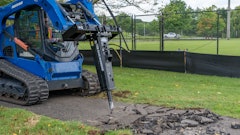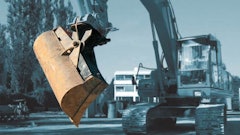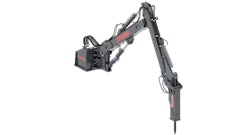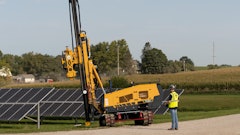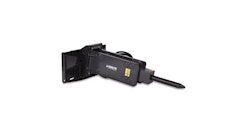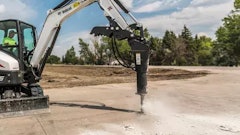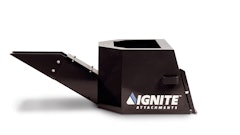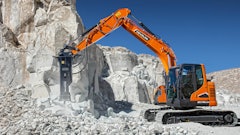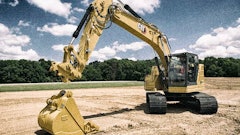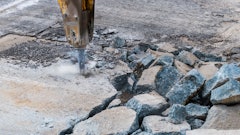The word hammer, almost by definition, is designed to beat itself to death,” notes Peter Bigwood, president of Atlas Copco Construction Tools, Inc. “The minute you put it on the job, the process of self-destruction is beginning.”
With the pounding hydraulic hammers are required to take, manufacturers have moved to simplify designs in an effort to enhance durability and performance. “In any piece of equipment, generally speaking, the fewer parts the better,” says Bigwood. “A part equals something more to go wrong. The more you have parts interacting and moving, the more wear and eventually repair and maintenance that will be required.”
“Designs featuring fewer components offer far better efficiency and performance, superior power to weight ratio and, in most cases, less carrier impact and more production,” adds Tim Miner at IPC Industries, manufacturer of the Huskie line of hammers. He attributes simplified hammer designs to advances in manufacturing techniques; more choices and types of steel; improved hydraulic seal technology; and better hydraulic systems on the carriers.
Such changes have contributed to lower acquisition and operating costs, Miner continues. “In 1972, using 1972 dollars, a 1,000-lb.-class hammer listed out for around $12,000 to $13,000 and carried a 90-day to 6-month warranty. For reference, in 1972, that’s what a Case 580 sold for,” he states. “In 2004 dollars, that same class hammer sells for $20,000 or less and offers roughly twice to three times the performance, negligible carrier impact and warranties that can stretch to three years and unlimited hours. In real dollars, today’s hammer is far less costly to buy and use.”
Developing a more “intelligent” hammer
Mike Grabnic, engineering supervisor, Allied Construction Products, LLC, describes newer hammer designs as more “intelligent.” “For example, they are better controlled internally,” he states. “The operating performance of the newer hammer designs provides better matches to the job requirements.”
Today’s hammers operate on a wider “band width” of flow and pressure, says Miner.
“They put less ‘load’ on the carrier hydraulic systems and will run without the addition of auxiliary coolers,” he explains. “They offer higher blow speeds and power at lower flows and pressures while still accepting higher flows for even better performance.
Older designs may require wide-open throttle and load the carrier to its maximum output.”
The ability to run cooler and adjust to a range of flows and pressures is a key selection criteria for Straight Line, Inc., a Las Vegas-based contractor specializing in residential footings and plumbing. Its owner, Randy Pinkston, has operated at least 20 different hammer brands over the past 25 years. Today, he uses primarily 1,000-lb.-class Huskie HH1000s on the company’s 32 Case 580 and 590 backhoe-loaders.
The hammers in the Straight Line fleet break up caliche prior to placing footings and plumbing for as many as 200 homes a day. “You can get into some soft caliche and be making 5 ft. in five or 10 minutes, then get into the next spot and you’ll be there a half hour moving the next 2 ft. It’s just that hard,” says Pinkston.
During the summer months, ambient temperatures in Las Vegas frequently reach above the 100º F mark. According to Pinkston, these hot, dry conditions actually require the carrier to be run at full throttle to ensure sufficient water and air is pumped through the radiator, keeping the machine and hydraulic system as cool as possible.
This has been a problem with older hammer designs. “If you want to slow it down to where it hits harder for really hard stuff, you have to slow the machine’s rpm to do that,” Pinkston explains. “Consequently, you’re gathering heat.”
Pinkston believes the newer hammers adjust more readily to changes in operating conditions. “The speed of repetition of hit seems to vary with the hardness of the soil conditions better with the Huskie,” he states. “The Huskie seems to not heat the machine as much. And as the hardness of the caliche changes, you can hear it hit different. If it hits more than three or four times and it’s really hard [material], it will slow down and hit harder. When it’s soft, it seems to drill it a little bit faster.”
Few modifications required
Brandenburg Industrial Service Co., Chicago, IL, is one of the largest demolition contractors in North America, with projects across the country. Its 80 hydraulic hammers include Tramac and newer Atlas Copco models ranging from 700 up to 20,000 ft.-lbs.
Many of the smaller hammers are used on skid steers for demolition inside buildings or in tight areas. Older hammer designs often required the addition of special plumbing to the skid steer in order to allow pressure in the return line to escape. “The newer hammers are more ‘off the shelf’ ready,” observes Mike Morrison, Brandenburg’s equipment division manager. “The newer hammers are not as sensitive to return line back pressure.
When we buy a new skid steer, that’s one less thing we have to modify before we put it into service.”
This has led to significant time savings, particularly on a recent project. “We did not have enough company-owned skid-steer loaders, so we had to get some additional ones,” Morrison explains. “We were able to do that in a timely manner because we obtained the skid steers, put the breakers on them and went to work. We did not have to modify the skid steers prior to putting them into service, which can take a week or so per machine.”
Fewer modifications also result in lower operating costs for the carrier. “There is a lot less maintenance during the life of that machine because you don’t have the additional components on there to relieve the pressure,” Morrison points out.
Big punch in a lighter package
Morrison also appreciates the higher energy output of newer hammer designs. “You break more concrete with a smaller hammer. You can use a smaller carrier. It’s easier to transport that smaller carrier and you can get into more places with it — parking garages, basements, things of that nature,” says Morrison. “The hammers are shorter, lighter and stronger. The dimensions are better, so there’s better visibility.
“The big difference in the newer hammers,” he continues, “is the energy output is higher, the maintenance cost is less and they’re doing more with less weight.”
Tom Pesacreta, field operations manager for Nuprecon, Inc., Snoqualmie, WA, has also witnessed improved performance from newer hammer designs. “The newer hammers are hitting harder than the older hammers,” he states. “It seems like they have more charge now.”
Nuprecon specializes in interior stripping and gutting, in addition to total building demolition. Its fleet includes seven 1,000-ft.-lb. Atlas Copco hammers for use on its Brokk demolition machines, plus roughly five hammers for its Bobcat skid steers. Larger hammers for excavators include a 3,000-ft.-lb. Allied model and a new 5,000-ft.-lb. Atlas Copco, which just came back from a project at the military base on Johnston Atoll Island in the South Pacific.
The Brokk units spend much of their time breaking up concrete walls and slabs inside buildings. Older, heavier, 1,000-ft.-lb. hammers proved cumbersome for these applications. “It’s slower plus it’s an anchor — it’s heavier,” says Pesacreta. “With the Brokks, you don’t want all that weight when you raise your boom out to break a concrete wall that’s 19-ft. tall. It’s not as desirable as the newer hammer that hits harder.”
The biggest benefit of newer hammers, adds Pesacreta, is production. “You’re just getting the job done quicker,” he states.
A recently completed project at a children’s hospital in Seattle serves as a perfect example. The job required bringing down two six-story wings off of the main building.
“After we got the wings down, we got into the footings. These footings were 12 ft. wide, 3 ft. thick and of course loaded with rebar,” Pesacreta explains. “We had some older [excavator-mounted] hammers we had rented and they just weren’t hitting, they were breaking down — they just weren’t working.”
With roughly three days to finish the job, Nuprecon contacted Hertz Rental Equipment and obtained two brand new Stanley hammers. “We got the hammers on Wednesday at noon. In two and a half hours, we had basically the majority of the footings all broken up,” says Pesacreta. “It was unbelievable. It just goes back to having the right piece of equipment.”
Built for Low Maintenance
Preventive maintenance on today’s hammers has been significantly reduced and is easier to perform, says Al Springer, national sales manager, Allied Construction Products. “Newer, smaller-designed hammers have been developed with non-breakable tools that offer exceptionally long service life,” he explains. “In addition, some newer, innovative hammers are practically maintenance free as no daily greasing is required.”
Tim Miner at IPC Industries agrees that maintenance has gotten much easier for hammers of all sizes. “Some new designs require no more preventive maintenance than grease twice daily and a brief walk-around each day,” he says. “Older designs might feature several dozen external fasteners and exposed hydraulic accumulators. That doesn’t make them bad; it just means there’s more to watch out for.”
Hammer suppliers are also using design changes to address common causes of unscheduled maintenance. For example, Atlas Copco has improved the way tension bolts are attached to the body on its larger hammers, plus the company introduced a solid body concept (SBC) on its smaller models.
According to Peter Bigwood at Atlas Copco, side bolts can become loose over time due to twisting motions applied to the hammer. If they are not tightened on a regular basis, the side plates and bolts can be damaged.
This is no longer an issue with the SBC design. “There are no side bolts and no tension bolts to hold it together because the actual body of the hammer has been cast in a single piece,” Bigwood explains.
Advances in hammer designs are succeeding in keeping hammers up and running longer. “I think the life is much greater on the newer hammers,” observes Mike Morrison, Brandenburg Industrial Service Co. “They’ve done things to protect the seals, the lower bushings on the breakers. They have dust suppressant built into the hammers now. In older times, you had to put special adapters on and all kinds of add-on pieces to be able to help keep the dust down.”
Certain designs also offer improved protection around the tool. “A lot of times you’re hammering overhead in a vertical position. Everything you’re breaking, the dust, is falling right into the nose or mouth of the hammer,” Morrison points out. “With some of the manufacturers, the newer models have a real nice system that prevents that from happening.”
Morrison adds to the list of benefits. “The hammers run cooler, they don’t build heat.
They have fewer moving parts,” he notes. “I could go on and on.”
So could Randy Pinkston at Straight Line, Inc. “They don’t wear the bushings as fast, and they’re less expensive to rebuild when you do rebuild them,” he says of his newer Huskie hammers. “I had one that went a year and a half [before rebuild] and usually it’s about every four months.”
Pinkston has also witnessed less stress being transferred back into the carrier. “The newer hammers hit harder by far and still have reduced the shock wave that goes into the tractor,” he states. “With the Huskie line, it has a little bit more weight, but the design of the side plates seems to absorb more shock than other hammers. I’ve never had a failure due to running these hammers on my tractors. And I’ve never had a hydraulic failure of the hammer that caused any problem with any of my machines.”
When it does come time for maintenance, advances in design are making this a fast, efficient process. “Newer, modular-designed hammers allow individual modules to be overhauled separately, which allows modules to be replaced in the field, further reducing downtime,” says Springer. “This is not the case with older hammers that have to be pulled out of the field and taken into the shop for repair.”
Ultimately, today’s designs are promoting added uptime and reduced parts and labor costs over the life of the attachment. “When you get right to it, downtime is really the most expensive thing,” Bigwood comments. “Even if you paid an extra $1,000 for a hammer, if it’s going to give you more consistent, more reliable performance, you’ll save the $1,000 many times over in not shutting your job down.”




